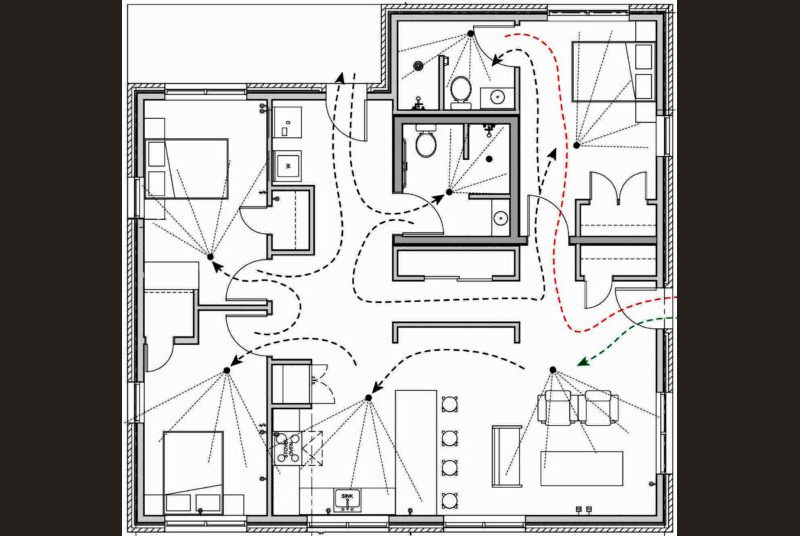Students look to stem climate change with the design/ build of a renewable energy residence in Bryan
A group of enthusiastic students is transforming an empty lot in Bryan into a 1,600 square-foot residence powered mainly by renewable energy – part of a new generation of homes that will dramatically reduce greenhouse gases, the main contributor to climate change.
The intensive design/build undertaking is Texas A&M’s entry in the Solar Decathlon Build Competition, a contest hosted by the U.S. Department of Energy, that includes 16 competing teams from 18 universities in 3 countries.
“The Solar Decathlon continues to be at the forefront of building the next generation of student leaders who can address climate change through the built environment,” said Holly Jamesen Carr, director of Solar Decathlon. “As these students take on the toughest challenges in the built environment, their bright ideas and creativity will be crucial in the transition to a clean energy economy.”
The student teams from architecture, planning, construction science and architectural engineering are creating designs and homes that will be scored in 2023 by expert juries on energy performance, environmental quality and impact, durability and resilience, their effect on the quality of life of its inhabitants, and more.
More than a home
Students have already designed the three-bedroom, two bathroom brick-and-mortar home with solar panels, large skylights, quadruple pane windows and LED lights. Drought-resistant plants and a rainwater collection system will be installed, along with extensive safety features like a safe room compliant with Federal Emergency Management Agency standards.
The safe room, outfitted with rations and water, looks like an ordinary bathroom, but is made with thicker, reinforced walls and can maintain power for up to seven days if a natural hazard strikes.
“Our project, with its highly efficient thermal envelope and controlled, natural daylighting, is driven by passive survivability, meaning if an event were to take place, you should be able to remain stay safe in your room,” said Gregory Luhan, Department of Architecture head and one of the faculty project leaders. “The house provides critical, life-supporting services for communications, refrigeration and illumination during a power loss, enabling residents to remain safe in their house through a hurricane, tornado or flood.”
Luhan said the house fully complies with the Americans with Disability Act, allowing residents to “age in place,” or live in their home safely, comfortably and independently regardless of age, income or ability level.
“We’re making more than a building,” said Luhan. “We are making architecture that provides shelter and elevates the homeowner’s spirit of place. By designing with that in mind, we specified innovations that would allow for a building that accommodates a long-term affordable home for a single family. Despite the anticipated slightly higher upfront cost than a typical Habitat for Humanity house, these innovative strategies will save the family money over the long term.”
Efficient and cost-effective design
For efficiency and affordability, the home will be able to operate for about $1 per day by utilizing natural resources like solar power.
“Many people are struggling right now,” said Aaron Shipp, ’10, director of construction at Habitat for Humanity, the student team’s leading project partner. “While on a fixed income, with inflation and everything happening globally, a dollar a day to run a house is great.”
The Texas A&M team ran a “life cycle analysis” on Habitat’s previous, local builds to have a baseline while trying to reach energy net zero, meaning more greenhouse gas is removed than produced with their project.
“We were able to reduce their carbon footprint by 75 percent,” said Luhan. “We’re still working on carbon net zero. We want to source things locally, but most of the higher energy items will need to be brought in.”
Community partnership
Texas A&M’s solar decathlon partners include the Bryan/ College Station Habitat for Humanity, which has built over 300 homes in the area.
“We’re looking at this project to see what we could utilize sustainably and affordably to implement in our builds,” said Shipp, who is also a Master of Construction Management student working on the project team.
“(Habitat) couldn’t do a project like this without A&M,” he said. “It’s a perfect fit. Altruism meets community engagement meets impact.”
Build
The home site, at 1613 Conlee St. in Bryan, has been prepared and the foundation is set to be poured in mid-January 2023, but Luhan said the team would need more on-hand funding to bring the project to completion.
The total costs are estimated at $310,000 but several community partners have donated in-kind labor and materials to help.
“We’re under very tight time constraints,” Shipp said. “Everything has to fall in line and we must use the maximum amount of resources in a small window to make this happen.”
For more information about volunteering, donations or partnerships, contact Heather Sauber, director of development at hsauber@arch.tamu.edu.
Previous Decathlon entries
A Texas A&M team entered and placed in multiple categories at the 2007 Solar Decathlon for their sustainable structure “groHome.” Thousands toured the project in College Station before it was reutilized as a sustainable industry training center for jobless community members in San Antonio in 2010. It was then moved in 2013 to a non-profit organization in Austin to be used as a Green learning lab.















